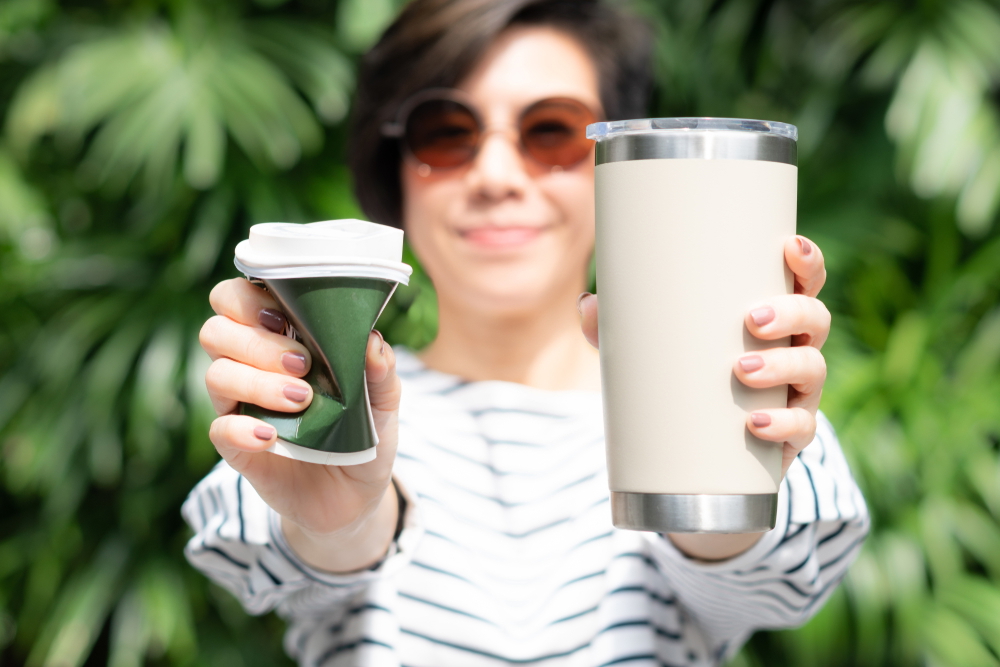Standard vs Biodegradable Paper Cups: Which Is Better for the Environment?
By Anttoni Taimela · 26. June 2024
Wondering if standard vs biodegradable paper cups are better for the environment?
🌍 This article compares their impact, materials, and recycling challenges, helping you choose the more sustainable option.
Understanding Standard Paper Cups
 group of friends holding up coffee cups celebrating
group of friends holding up coffee cups celebrating
Standard paper cups, also known as disposable cups, have become a ubiquitous part of modern life, especially for those using paper coffee cups on the go.
☕ These disposable cups are primarily composed of paperboard. What makes most paper cups particularly resilient and suitable for liquids is a polyethylene or plastic coating that lines the inside.
This plastic lining is essential for waterproofing and durability, ensuring that your coffee cup doesn’t disintegrate before you finish your drink.
However, this very feature that makes them so convenient also poses significant challenges when it comes to recycling.
The fusion of paper and plastic materials means that standard paper cups cannot be processed like pure paper products, complicating their disposal and recycling.
Understanding the materials and construction of these cups is the first step in grasping the broader environmental implications.
As we move forward, we’ll explore just how significant these implications are, especially when billions of such cups are used and discarded annually.
Environmental Impact of Standard Paper Cups
Each single-use coffee cup has a carbon footprint of up to 60.9 grams of CO2e. When you consider that over 2.5 billion coffee cups are used annually in the UK alone, the environmental cost becomes clear, consuming up to 1.45 billion litres of water in the process.
The journey of these cups from raw material extraction to production and transportation requires significant energy, contributing to environmental degradation.
Once they have served their purpose, an estimated 50 billion paper cups end up in U.S. landfills every year. Here are some key environmental impacts of paper cups:
- The standard polyethylene-lined paper cup takes about 20 years to decompose, releasing methane, a potent greenhouse gas, as it breaks down anaerobically.
- The production of paper cups contributes to deforestation and habitat destruction.
- The manufacturing process of paper cups requires large amounts of water and energy.
- The transportation of paper cups adds to carbon emissions.
These environmental impacts highlight the need for more sustainable alternatives to paper cups.
What Makes Biodegradable Paper Cups Different?
 recyclable paper cup
recyclable paper cup
Biodegradable paper cups offer a glimmer of hope in the quest for more sustainable disposable coffee cups.
🌱 Unlike their standard counterparts, these biodegradable coffee cups often feature a PLA (polylactic acid) coating, derived from natural sources like corn starch or sugarcane.
This PLA coating sets biodegradable cups apart because it allows them to be turned into 100% organic compost, making them a compostable coffee cup option.
When these compostable cups come into contact with water and soil, they are designed to break down into organic matter, significantly reducing their environmental footprint.
On average, biodegradable paper cups can decompose within six months, given the right conditions.
This is a stark contrast to the decades it takes for standard paper cups to break down, making biodegradable options a more eco-friendly alternative for those who still prefer the convenience of single-use cups.
How Biodegradable Paper Cups Decompose
The decomposition process for biodegradable paper cups is fascinating and significantly more efficient than that of standard cups. PLA-coated paper cups require both heat and moisture to compost effectively.
In industrial composting facilities, these conditions are meticulously controlled, allowing biodegradable cups to break down much faster.
For instance, in an industrial setting, these cups can decompose in less than a month at temperatures of 60-65 degrees Celsius.
This regulated environment ensures that biodegradable materials like PLA break down into water, carbon dioxide, and biomass, unlike traditional plastics that can take centuries to decompose.
Home composting presents a different scenario. While it is possible, it requires more effort to maintain the right conditions.
Turning the compost pile regularly and ensuring deeper pits can help accelerate the process, but it will still take up to 90 days for PLA products to decompose in a home compost.
Understanding these nuances helps consumers make informed decisions about disposal methods.
Comparing the Environmental Footprint
When comparing the environmental footprint of standard and biodegradable cups, the differences are striking.
The production of PLA, used in biodegradable cups, typically has a lower carbon footprint as it is made from renewable sources like corn starch or sugarcane.
This leads to fewer greenhouse gas emissions during production compared to traditional plastic cups.
Furthermore, the disposal of biodegradable cups results in significantly fewer carbon emissions. While they may feel similar to traditional plastics, their eco-friendly benefits are undeniable. The overall reduction in environmental impact makes biodegradable cups a more sustainable choice.
Challenges in Recycling Standard Paper Cups
Recycling standard paper cups is fraught with challenges, primarily due to their plastic lining. This lining makes it difficult to recycle these cups alongside other paper products, often leading to microplastics leaching into the environment.
The infrastructure for recycling these cups is limited, with only three out of 450 U.S. paper recycling mills capable of processing plastic-coated cups. In the UK, the recycling rate for paper cups is just 6%.
To combat this, cup recycling projects are being implemented in closed environments like shopping centres and airports to improve the recycling infrastructure.
Despite these efforts, the slow decomposition of most disposable cups, especially those with plastic linings, continues to pose a significant environmental challenge.
The Reality of Compostable Packaging Claims
Compostable packaging claims can often be misleading. While compostable products meet specific criteria under certain conditions, many items labelled as such may be nothing more than marketing gimmicks.
Consumers must be aware of proper disposal methods and local regulations to ensure these products provide the intended environmental benefits.
Different municipalities have varying approaches to accepting compostable packaging, which can confuse consumers.
Field-based testing of compostable packaging is becoming more common to ensure materials decompose properly in actual composting environments.
It’s crucial for consumers to follow designated commercial food waste streams and avoid mixing non-compostable materials.
Consumer Behavior and Disposable Coffee Cups
 woman holding reusable takeaway coffee cup and paper cup
woman holding reusable takeaway coffee cup and paper cup
Consumer behaviour plays a pivotal role in the environmental impact of disposable coffee cups. Improper disposal can result in litter that harms wildlife and ecosystems.
The confusion caused by the similar appearance of different types of disposable cups adds to the challenge.
Raising awareness about sustainable options and encouraging proper disposal practices are essential steps in mitigating the environmental impact of disposable coffee cups.
The Role of Reusable Cups
Reusable cups stand out as the most sustainable option among all. Despite requiring a higher initial investment, they offer long-term cost savings.
Using a reusable cup also enhances a brand’s reputation by showcasing a commitment to sustainability.
These cups provide marketing opportunities by turning each cup into a promotional item. Additionally, they improve the customer experience due to their perceived higher quality.
Overall, reusable cups are the most eco-friendly alternative to both standard and biodegradable disposable cups.
Summary
In summary, while standard paper cups and biodegradable paper cups each have their pros and cons, biodegradable cups offer a significantly lower environmental footprint, especially when disposed of correctly.
However, the most sustainable choice remains reusable cups, which provide long-term benefits both environmentally and economically.
By making informed decisions about the cups we use and how we dispose of them, we can collectively reduce our environmental impact and contribute to a healthier planet. 🌿 Let’s choose wisely and act responsibly.
Frequently Asked Questions
Why are standard paper cups difficult to recycle?
Standard paper cups are difficult to recycle due to the plastic lining that makes them hard to process in standard recycling facilities, resulting in low recycling rates and environmental challenges.
How long does it take for biodegradable paper cups to decompose?
Biodegradable paper cups can decompose within six months under the right conditions, with industrial composting facilities processing them in under a month.
What is PLA, and why is it used in biodegradable cups?
PLA, or polylactic acid, is used in biodegradable cups because it is derived from natural sources like cornstarch or sugarcane, allowing the cups to break down into organic compost.
Are compostable packaging claims always reliable?
Compostable packaging claims are not always reliable, as some products may not meet criteria, and consumers need to follow proper disposal methods for environmental benefits.
What are the benefits of using reusable cups?
Using reusable cups can provide long-term cost savings, enhance brand reputation, offer marketing opportunities, and improve customer experience, making them the most sustainable option.

